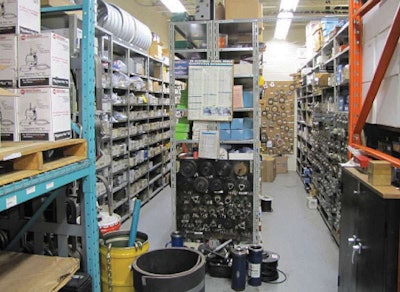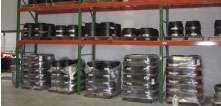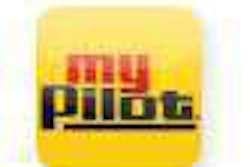6 tips fleets can learn from dealers to manage inventory more efficiently
When it comes to managing a parts department’s inventory, there’s always room for improvement. A well-run department can be a great asset, while a disorganized department can become a financial burden and have a negative effect on productivity.
Truck service providers that consider their parts departments an asset say it takes constant improvement and attention to detail to keep things from becoming the latter. They know that providing timely service can make or break a relationship with a truck fleet – and having a ready supply of parts on hand is a key component to providing timely service.
With careful planning, carriers can make their parts departments more organized.
Many of the methods used by truck dealers across the country can be integrated successfully into a fleet’s service department. Whether it is located at a dealership or on the edge of a fleet’s maintenance bay, the parts department serves the same purpose – to get the right parts to technicians so they can put trucks back on the road as quickly as possible.
Darry Stewart, president of DWS Fleet Management, says parts inventory is the single-most vital contributor to an efficient fleet operation – and the most overlooked. “A parts shop should be as clean and well-organized as a supermarket,” says Stewart, who estimates he’s reorganized more than 250 parts shops in his career.
A parts foreman has control over keeping technicians productive and getting trucks back on the road. “If you figure it costs you a dollar a minute every time a technician is looking for a part instead of installing it, you see how quickly your repair costs can escalate.”
1: Know what techs need
 A parts department’s main goal is to have a realistic inventory of usable parts at all times.
A parts department’s main goal is to have a realistic inventory of usable parts at all times.The first step to creating an effective parts department is understanding who needs the parts and how they do their jobs. John Wilson, operations manager for Empire Truck Sales, says that talking to technicians, drivers and shop foremen on a routine basis can help a fleet predict common repairs and parts requirements.
“When it comes to your parts department, you have to be proactive in planning your inventory,” Wilson says. “Market demand drives your inventory, so you want to try to look at your fleet and know what they are going to need.” This means closely examining equipment needs, the parts and components used on that equipment, hauling schedules, routes and road conditions.
Careful recordkeeping is another vital element. Consistently tracking repairs – types of breakdowns, repair times and parts used – gives an operation a baseline as to the types of repairs it handles more routinely. Wilson says a fleet probably won’t see two repairs that truly are identical, but with research and consistent recordkeeping, it can identify trends and common problems – and the parts stock to meet those needs.
Wilson recalls the opening of Empire’s location in Brookhaven, Miss. “When we opened that facility, we did a study of the demographics of the trucks in the area so we knew what types of problems were common to our potential customers,” he says. “We wanted to know what to expect.”
After completing the study, Empire created a list of “mission-critical parts” that would be a priority to stock and reorder on a consistent basis. The list was designed to speed up the process of completing common repairs and provide the service center with an adequate amount of inventory for problems seen most frequently.
“Your goal has to be to have a realistic inventory of usable parts available at all times,” Stewart says.
2: Automate the procurement process
 Frame Service’s parts department has a computer software system that logs all parts sold and used.
Frame Service’s parts department has a computer software system that logs all parts sold and used.Computers do many things for truck fleets today, and one of their most powerful capabilities is to process and organize different streams of data into a single, coherent message – a blessing for a swamped fleet manager trying to gain insight into parts procurement and stock. Selecting the right program for an operation – and then giving the software accurate information to process – is vital to success.
Frame Service’s parts department has a computer software system that logs all parts sold and used in repairs. The system is designed to reorder stocked parts automatically once they leave the shelf and to update inventory.
The system allows parts manager Sue Platt to see what is coming off the shelves quickest, but it also reveals what isn’t selling or moving – and she uses that information to gain a better understanding of her customers and their needs.
“The program does a great job, but it doesn’t see everything,” she says. “It can’t look into the future and see a customer is planning to bring in several trucks, or see that the weather is changing or that a new part has made another one obsolete. You still need the human element for that sort of thing.”
Before any stock orders at Frame Service are finalized, a staff member checks the computer-generated order against consumer trends, customer information and other outside factors so that Platt orders a suitable quantity of any part at any given time.
“If we are having a run on something, we will be aware of that,” she says. “The computer will know we are out of what we had on the shelf, and it will automatically order parts to refill the shelf. But it doesn’t realize we may need to order more than we typically use if outside factors are in play.”
Another possibility is to relinquish some inventory control to vendors that specialize in a specific product. One such example is Tire Centers (TCi), which recently unveiled its new Track My Tread software program. “We know from talking to fleets that tire management is a particularly tough part of the whole parts inventory puzzle,” says Nate Kirian, vice president of marketing for TCi.
Track My Tread is an online tool designed to allow fleets to see and control tire assets throughout their lifecycle. From purchase to repairs to retreading and on to the scrap pile, the customer has visibility and control at his fingertips, providing him with accurate reporting and a true total cost of ownership throughout the tire’s lifecycle, Kirian says.
3: Expedite the parts delivery process
Knowing when parts will be delivered from suppliers helps when it comes to avoiding vehicle downtime. Successful dealerships are proactive when it comes to parts acquisitions; good parts suppliers recognize the time-sensitive nature of a fleet or dealership and respond accordingly.
Joe Kory, vice president of global distribution operations for Navistar, says the majority of parts delivered to an International dealership come through daily stock orders made by fax or through an online retail inventory management system. The parts will reach a dealership in two to five days, a schedule that gives a dealership time to stock up on parts it may need in the near term and helps control the flow of fast-moving parts, Kory says.
Daily stock replenishment also allows a parts manager to notify a technician or customer exactly when a part will arrive once it’s been ordered. If a part hasn’t been ordered and isn’t in stock but is needed immediately, the dealership can request a rush order that can be provided in several ways.
Tidewater Fleet Supply provides parts delivery to its customers on an hourly basis, meaning every order is expedited whether needed quickly or not. With nine delivery runs per day, customers can receive a stock order and a rush order in the same workday, says Allan Parrott, president. Tidewater doesn’t differentiate between the types of orders.
Another way to provide a rush order is through specific deliveries. Wensel Truck Centers’ three locations receive stock orders from a variety of different vendors. When one of those locations needs a rush delivery for an unstocked part, it will contact the distributor and request a rush order. Sometimes the part is delivered through a third-party logistics company, while other times the delivery will be made by the distributor.
But how it gets there doesn’t matter as much as when it gets there, says John Wensel, owner and chief executive officer. Wensel says his locations try to stock 90 to 95 percent of parts needed for any repair order, and when one isn’t in stock, it’s imperative that it gets shipped quickly. He says it doesn’t do his service center or a customer any good to wait days for a part to arrive.
4: Reorganize inventory based on volume
In a parts warehouse, saving space is critical. No fleet service provider can stock everything, but having an organized, efficient warehouse layout can maximize a department’s inventory. “No one wants to deal with a 
Stewart recommends starting from scratch. “You have to assemble a team and then empty the building,” he says. “Then clean, paint and reorganize everything from the bottom up. When you’re done, every part should be in a box and have a specified place – just like a supermarket.”
At Frame Service, when extra parts are added to a stock order due to projected sales, space has to be made for them. Frame Service’s warehouse is a fixed size, so the addition of two large parts may mean the reorganization of a shelf or entire department wing.
“If we start carrying more of something, we have to know where we can stock it,” Platt says. “We try to move the things we sell less of to the back of the shop so we have space up front for the things that are moving.”
Navistar recommends a similar protocol for its dealer network and offers new members a buyback system for nonmoving parts to help clear inventory and maximize available warehouse space.
“When a new member first comes on, we offer a one-time cleanup and buyback program they can use to get rid of those nonmoving parts,” says Thom Meehan, director of supply chain inventory control for Navistar. “The program is designed to let them reinvest. It rids the dealer of the parts he isn’t selling and lets him stock up on what is selling.”
Wensel also purges nonmoving parts at his service centers. Once a year, his company clears excess inventory from its warehouses and send it back to distributors. The removals give him the opportunity to catalog and reorganize his inventory more efficiently.
5: Create a plan for techs
 At wensel truck centers, the counter staff finds out which parts are on the shelves.
At wensel truck centers, the counter staff finds out which parts are on the shelves.Another key to a profitable parts inventory is standardizing a way to shuttle parts and parts requests from technicians to the parts department – and vice versa. Operating an efficient parts department is difficult enough; there’s no need to make it harder with miscommunication.
Empire’s technicians use an electronic requisition form to request parts from the warehouse without leaving their service bays; parts employees then fill the requests and bring the parts to the technicians. Once a part has been provided to a technician, it is added to the rush-order ledger and reordered for the next incoming stock order.
Parts requested by the technician but not in stock are ordered by the parts department, and the computerized system then notifies the technician of the rush order. The system keeps the parts department in charge of actual parts ordering and inventory, and allows the technicians to focus their attention on repairs.
At Wensel Truck Centers, technicians manually fill out a parts request form that they provide to the parts department; from there, the counter staff finds which parts are on the shelves and which ones need to be ordered.
“Sometimes the techs will speak with the counter people to show them what they need so the counter guys know exactly what to get, but we don’t want them too involved with ordering parts,” Wensel says. “The best way for our shop to be productive is for our technicians to be working on trucks.”
6: Consider outsourcing
Another possibility to consider when streamlining parts inventory is simply to outsource the operation completely. Pressures to reduce operating costs have led to the elimination of the position of parts manager at many fleets, leaving the task of handling a major-expense line item to the fleet owner or manager.
One outsourcing system now gaining traction with fleets is vendor-managed inventory, where the manufacturer or supply distributor maintains all or part of a fleet’s inventory. The system was implemented in the 1980s by large corporations like Wal-Mart and has become standard in segments of the retail industry.
“It is now on the upswing in the aftermarket truck parts industry,” says David Nitzsche, vice president of supply management for AmeriQuest Transportation Services. Most of the top heavy-duty truck parts suppliers have active VMI programs, while more than 70 percent of the top 100 distributors have them, Nitzsche says.
The vendor monitors a fleet’s sales and inventory levels and manages reordering calculations based on actual demand, lead time and other factors. The system then recommends parts that need to be replenished and places the orders. Both the supplier and fleet keep communications to a minimum, confining it to exceptional situations.
“VMI makes sense to a fleet because it frees up personnel for other tasks,” Nitzsche says. The parts supplier provides scanning devices, barcode labels and other technologies so that the fleet always has real-time data on inventory levels; the data triggers a replacement cycle as needed. For fleets with multiple locations, the system can determine when one part is sitting unused in one location when it may be needed in another; the part can be pulled and transported, automatically triggering a reorder as needed.
One of the biggest benefits to a fleet is visibility of parts inventory, Nitzsche says. “Overstocked or unused parts are really dollars sitting on a shelf,” he says. “Those dollars also may be obsolete parts that will eventually be sold for perhaps 20 percent on the dollar, costing the fleet 80 percent of their value.”
A computerized system recognizes when a part is near obsolescence and will trade it for a new part when appropriate. Some suppliers also provide parts on consignment and will charge only for what is used, Nitzsche says.











